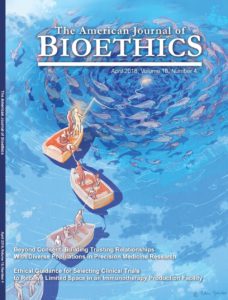This editorial also appears in the April 2018 edition of the American Journal of Bioethics.
by David Magnus, PhD and Jason N. Batten, MA
This issue of the American Journal of Bioethics features an article on the importance of building trusting relationships for the successful creation of research repositories that include biospecimens and data records from under-represented ethnic and racial groups in the U.S. Other researchers have made note of this challenge (including most of this research group in relation to learning health system research). This editorial will focus on two important points raised by Kraft et al. and discussed in the outstanding set of commentaries.
First, bioethics, research ethics, and regulatory system have been too focused on informed consent as the primary vehicle of respect for research participants. There has been some interesting recent work (in addition to the target article) about ways of moving beyond consent to consider other ways of demonstrating respect for patients. The target article argues that, although consent may be necessary, it is insufficient for addressing concerns of participants and especially for building a trusting relationship. What is unstated or unexplored is the relationship between asking permission (the autonomous authorization sense of informed consent developed by Faden and Beauchamp) and the informed consent documents that are typically the focus of so much attention by IRB’s. As an IRB member at Stanford and Vice Chair of the “All of Us” precision medicine initiative IRB, one of us (DM) has spent significant time ensuring that informed consent forms meet the well-established regulatory requirements (along with the shadow regulations, relevant guidance, and established ethical norms governing research). But in practice, as those of us who have attempted to do web-based recruitment for research know, potential participants have usually made up their mind by the time they look at the informed consent forms. If they go to the time and trouble of reading through those, it usually means they have already decided that they want to sign up. How did they make that decision? And why?

At least one important part of that process is the recruitment materials that introduce prospective participants to research. IRB’s typically have some guidance about what recruitment materials should look like, but compared to informed consent, there is little in the regulations that specifies what is required. As large-scale efforts to build research repositories are underway and some of that effort is to be web based (such as the “All of Us” Direct Volunteer Program), there will be at least two challenges to ethically appropriate engagement with potential participants. First, the line between recruitment and other public communication (press releases, articles about the topic, efforts to educate the public about precision health) is blurry from the point of view of the participants. They may not appreciate the sharp line demarcating regulated from unregulated activity, and the whole of communication may be as important as the consents in determining whether or not someone will participate and whether they are doing so due to understanding or a misconception. Second, the transition from small, local efforts at recruitment to larger, national recruitment or private sector recruiting (e.g., 23 and me, Google’s Project Baseline, and others) is leading to a shift from thinking of early engagement of potential participants as recruitment to thinking of it as an advertising campaign. This shift will be hard for IRB’s to evaluate, particularly since they have been given far less guidance in evaluating advertisement and other communication strategies than they have for evaluating consents—in spite of the fact that for much of this research, these other communication strategies are likely more important.
A second point raised by Kraft, et al is the ethical importance of ensuring that the institutions engaged in recruitment are trustworthy. This is actually a daunting task. The authors do not attempt to tackle the relationship between trust and trustworthiness. But normatively, the two concepts, while related, are distinct. We hope that potential participants will trust institutions that are trustworthy and be more cautious with institutions that are not. But it is not obvious that that is the case. In King Lear, Cordelia was by far the most trustworthy of the king’s daughters. But he did not trust her with her share of the kingdom. Instead he gave the kingdom over to his less trustworthy daughters (whom he trusted more). It turned out that base flattery was a way of establishing trust with the king—but not of establishing that anyone was worthy of that trust.
Several of the commentators raise approaches (such as deliberative democracy) that can serve to establish “trusting relationships” between communities and researchers. And Kraft, et al discuss the ways that governance and oversight, and explicit engagement with concerns around history and mistrust, and the potential for group harms, can all build trust. But it is not clear if these are meant to establish and build trust or to ensure that the institution is trustworthy. Ongoing research exploring the various ways of establishing respect for participants, and for demonstrating a culture of integrity, is essential for creating a trustworthy research enterprise. But more work needs to be done to avoid the King Lear problem and help potential participants place their trust in institutions that are truly trustworthy.